Prediction of Climate Variations and its Application in the Southern African Region
Ⅰ.Seasonal forecasts
South Africa Risk and Vulnerability Atlas (http://rava.qsens.net/themes/climate_template)
SINTEX-F1 on the global domain
( http://www.jamstec.go.jp/frcgc/research/d1/iod/e/seasonal/outlook.html)
Ⅱ.Selected research topics: sub-tropical dipoles and coupled models’
development activities, etc.
- On the growth and decay of the subtropical dipole mode in the South Atlantic
(by Morioka et al.)
Using observational data and outputs from an ocean general circulation model, the growth and decay of the South Atlantic subtropical dipole (SASD) are studied. The SASD is the most dominant mode of interannual variability in the South Atlantic and its sea surface temperature (SST) anomaly shows a dipole pattern oriented in the northeast-southwest direction. The positive (negative) pole develops because the warming of mixed layer by the climatological shortwave radiation is enhanced (suppressed) by the thinner (thicker) than normal mixed layer. The mixed-layer depth anomaly is due to the suppressed (enhanced) latent heat flux loss associated with the southward migration and strengthening of the subtropical high (the upper four panels in the figure). During the decay phase, since the temperature difference between the mixed layer and the entrained water becomes anomalously large (small) due to the positive (negative) mixed-layer temperature anomaly, the mixed-layer cooling by the entrainment is enhanced (reduced) (the two panels in the third row). In addition, the mixed-layer cooling by the climatological latent heat flux is enhanced (suppressed) by the same thinner (thicker) mixed layer (the two panels in the bottom). The present work demonstrates the importance of taking into account the interannual variations of the mixed-layer depth in discussing the growth and decay of SST anomalies associated with the SASD.

Schematic of (a) growth and (b) decay mechanisms of the positive and negative SST anomaly poles for the positive SASD. Red (Blue) color indicates the positive (negative) mixed-layer temperature anomaly. Please refer to the table for the other symbols.
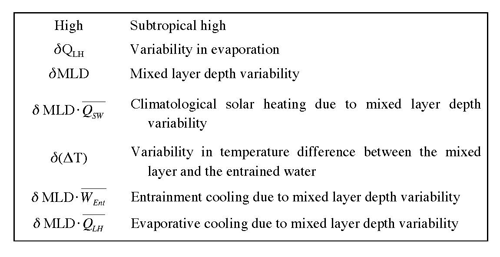
Morioka, Y., T. Tozuka and T. Yamagata: On the growth and decay of the subtropical dipole mode in the South Atlantic, Journal of Climate, in press.
- Key factors in simulating the equatorial Atlantic zonal sea surface temperature gradient in a coupled g eneral circulation model (by Tozuka et al.)
Causes of the air-sea coupled model bias in simulating the zonal sea surface temperature (SST) gradient in the equatorial Atlantic are examined in three versions of the same air-sea coupled general circulation model (CGCM) differing only in the cumulus convection scheme. One version of the CGCM successfully simulates the mean zonal SST gradient of the equatorial Atlantic, in contrast to the failure of the Coupled Model Intercomparison Project phase 3 models. The present analysis shows that key factors to be successful are high skills in simulating the meridional location of the Intertropical Convergence Zone, the precipitation over northern South America, and the southerly winds along the west coast of Africa associated with the West African monsoon in boreal spring. Model biases in the Pacific contribute to the weaker precipitation over northern South America. Uncoupled experiments with the atmospheric component further confirm the importance of remote influences on the development of the equatorial Atlantic bias.

↑Annual mean sea surface temperature in the equatorial Atlantic Ocean. The shading shows the spread (1 standard deviation) of 22 Coupled Model Intercomparison Project phase 3 (CMIP3) models. UTCM_Kuo means results from our coupled model named University of Tokyo Coupled general circulation Model (UTCM) with the Kuo convection scheme. UTCM_Emanuel and UTCM_Tiedtke are same but with the Emanuel and Tiedtke convection schemes, respectively. Only the UTCM with the Kuo scheme successfully simulates the observed zonal gradient of SST.
Tozuka, T., T. Doi, T. Miyasaka, N. Keenlyside, and T. Yamagata (2011), Key factors in simulating the equatorial Atlantic zonal sea surface temperature gradient in a coupled general circulation model, J. Geophys. Res., 116, C06010, doi:10.1029/2010JC006717.
- Evolution mechanism of the Indian Ocean subtropical dipole mode (Morioka et al.)
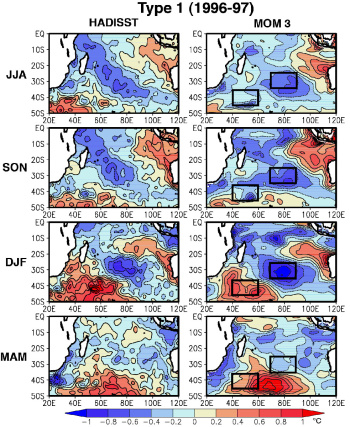
Yushi Morioka and his colleagues of the University of Tokyo investigated evolution mechanisms of the subtropical dipole mode in the southern Indian Ocean. They classified interannual anomalies of sea surface temperature into nine types using self-organizing map technique and examined their evolution processes using an ocean general circulation model. They found that variation in thickness of ocean surface mixed layer, by which ocean receives solar irradiance, is largely responsible for the evolution of the sea surface temperature anomalies. The warming of the mixed layer by the climatological shortwave radiation is enhanced (suppressed) as a result of anomalously thinned (thickened) mixed layer, which gives rise to warmer (cooler) sea surface temperature anomalies and thus occurrence of the subtropical dipole mode.
↑Sea surface temperature anomalies over four seasons (Jun.-Aug., Sep.-Nov., Dec.-Feb., and Mar.-May) for one typical positive Indian Ocean subtropical dipole event during 1996-97. Observational data (HADISST) are shown in the left panels, whereas output from the ocean general circulation model is shown in the right panels. The contour intervals are 0.2 ºC. The black boxes indicate the positions of the poles of sea surface temperature anomalies.
Morioka, Y., T. Tozuka, and T. Yamagata, 2010: Climate variability in the southern Indian Ocean as revealed by self-organizing maps. Climate Dynamics, 35, 1075-1088.
Ⅲ.Dynamical downscaling activities: Limpopo Province and Western
Cape regions
Ⅳ.Statistical downscaling: Application studies for agriculture and water
management including processed data provision through cell phones to
local farmers.
Ⅴ.Lecture series for capacity building
- Lecture series (March 4th, 2012 to March 15th, 2012)
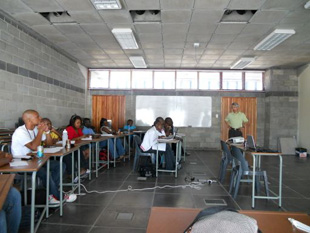 |
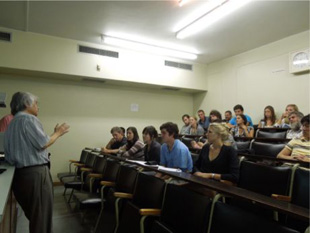 |
|
| Lecture Scene | Lecture Scene |
- Lecture series (October 9th, 2011 to October 22th, 2011)
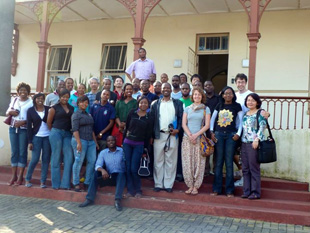 |
||
| With students |
|
- Lecture series (February 20th, 2011 to March 10th, 2011)
Prof. Motoyoshi Ikeda, Dr. Motoki Nagura, Dr. Wataru Sasaki and Dr. Satyaban Ratna visited four Universities (University of Pretoria, UP; University of Western Cape, UWC; University of Cape Town, UCT; Rhodes University, RU) and one governmental institute (South African Weather Services, SAWS) in South Africa to give lecture series. Prof. Ikeda gave lectures about general knowledge of climate change and role of the ocean. Dr. Nagura, Dr. Sasaki and Dr. Ratna gave lectures about technical issues at UP and SAWS and made research-based presentations at UWC and RU.
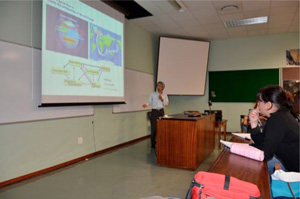 |
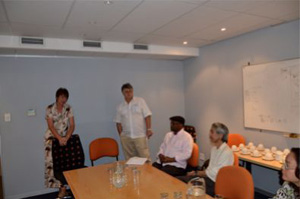 |
|
| Lecure by Prof. Ikeda at University of Pretoria | Meeting with SAWS people |
|
 |
 |
|
| With UWC faculties | With RU people |